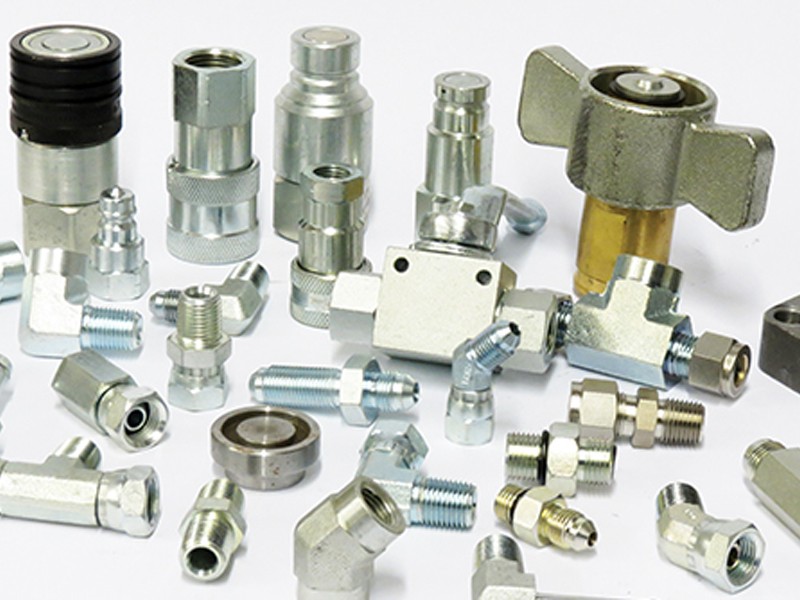Pneumatic fittings connect sections of pipe, tube and hose in pressurized gas systems. Compared to hydraulic fittings, pneumatic fittings are generally characterized by tighter seals and lower pressure requirements. They are common in pneumatic logic control systems and instrumentation. We will discuss pneumatic fitting specifications and materials.
Specifications of Pneumatic Fittings
Sizing
Once you have determined the type of fitting required, proper sizing can be addressed. Proper sizing is essential to successful fitting selection. This is because oversized or undersized parts will either be completely incompatible or will seal or connect inadequately.
A pneumatic fitting size is defined by the size of vessels it connects to. Sizes for tubes, hoses and pipes use the inside diameter (ID) and outside diameter (OD). Measurements are inches (in) or millimeters (mm). The fitting’s design is ideal for connecting a tube with a 2″ OD have a rating of 2″ OD fitting. Inside diameter measures the diameter of the empty portion of the cylinder. However, outside diameter diameter involves the thickness of the tubing wall.
Operation
Pneumatic fittings ratings are usually for specific temperature and pressure ranges for what they can handle.
The working range of pressures or the pressure ratings at which the fitting can operate is the operating pressure range. Generally, measurements are in pounds per square inch (psi). Operating above or below this rating can result in the fitting failing (i.e. break, leak, lose its seal).
The working range of temperatures or the temperature ratings at which the fitting can operate is the operating temperature range. Measurements are in degrees Fahrenheit (°F) or degrees Celsius (°C).
Materials Used for Pneumatic Fittings
Fitting material is critical for determining a variety of physical properties of the part as well as gas compatibility. Material options include metals, plastics and composites.
Metals
Aluminum
Aluminum is lightweight and corrosion resistant. In addition, it has low tensile strength and is common in low pressure applications for its corrosion resistance and low density.
To improve its strength and hardness, aluminum is alloyed with zinc, copper, silicon, manganese and/or other metals.
Brass
Brass is strong, durable and corrosion resistant. Also, it has high temperature ductility and good conductivity, and is is an alloy of copper and zinc.
Brass contains excellent performance properties and machinability. Therefore, it is a common metal for smaller compression and fitting that uses threading, which is typical of pneumatic systems.
Steel
Steel is durable and strong with high heat resistance. It is an alloy of iron and carbon. In addition, it is generally alloyed with other metals to improve its resistance to corrosion.
For added rust protection and chemical resistance, galvanized steel contains a zinc coating.
Stainless Steel
Stainless steel is strong with a great resistance to chemicals and corrosion. Additionally, it is an alloy of steel that contains over 10.5 percent chromium.
This metal has the strength and durability of steel while also providing excellent resistance to corrosion.
Plastics
Fluororesins
Fluororesins such as polytetrafluroroethylene (PTFE) and polyvinylidene fluoride (PVDF) are fluorcarbon-based polymers common for temperature requirements above 500°F (250°C).
Additionally, this plastic exhibits extremely good chemical resistance and dielectric properties.
Polypropylene
This thermoplastic material is common for pneumatic fittings because of its price, broad material compatibility and durability. It exhibits great cold flow, bi-axial strength and yield elongation properties.
The use of this material is great for applications with exposure because of its UV, weathering and ozone resistance.
Composites
Composite fittings consist of those made from combinations of materials, such as carbon, fiberglass and graphite. Also, they have high melting points and are useful as fittings for applications that require high temperature durability and chemical resistance. These materials also exhibit low electrical and thermal conductivity.
Don’t hesitate to contact Bryan Hose & Gasket with the link below for more information or to purchase your pneumatic fittings today!

